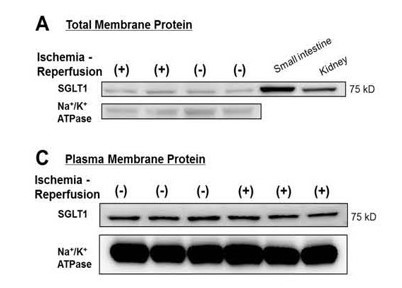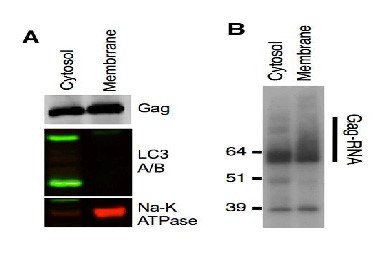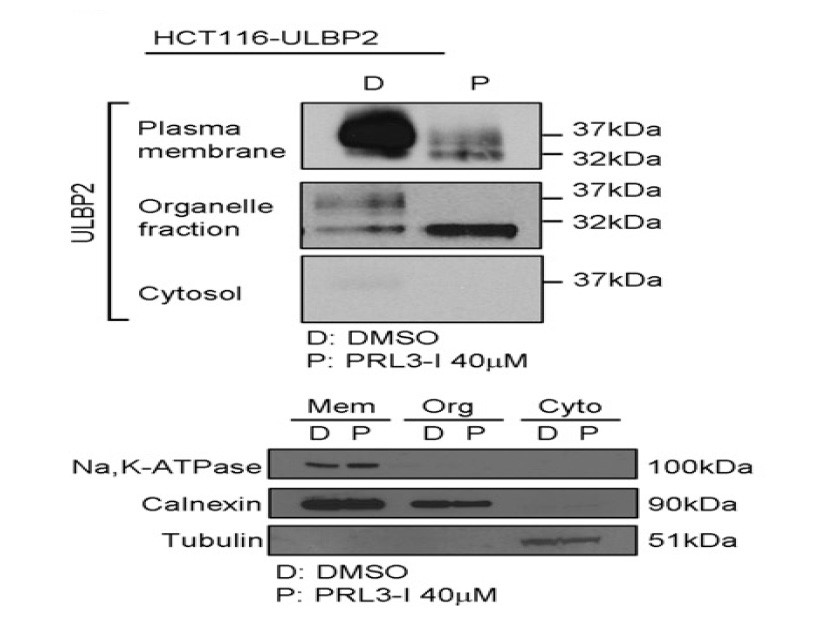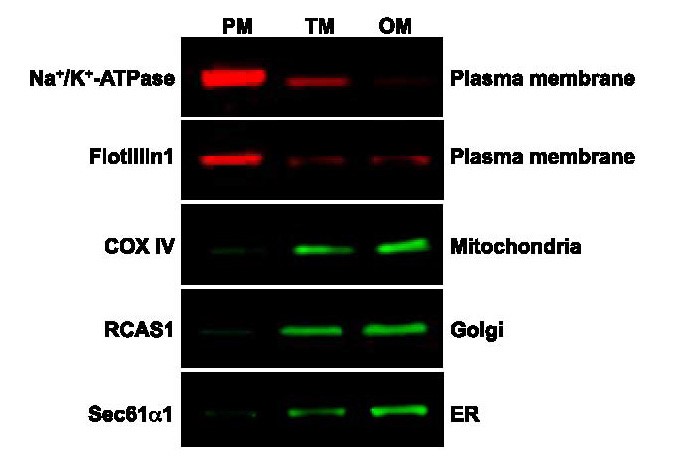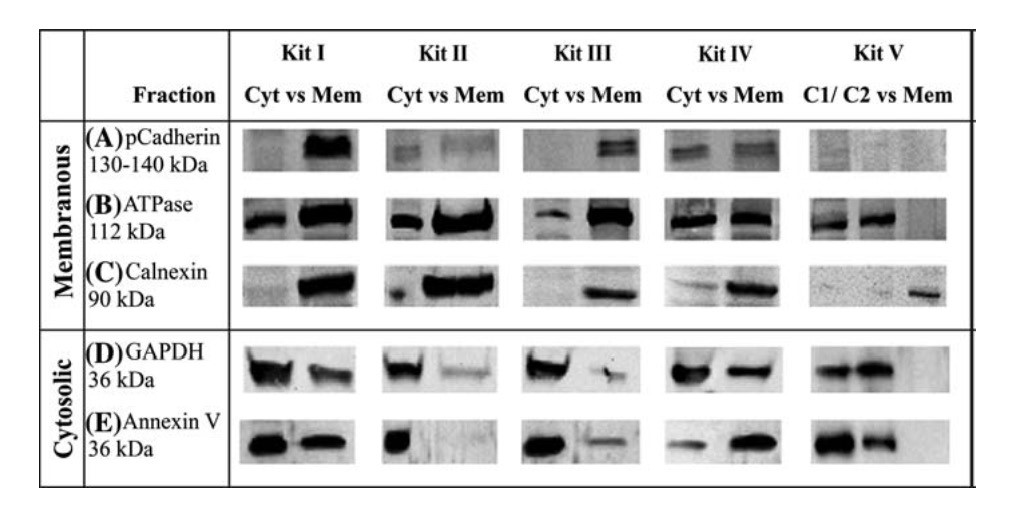Plasma membrane (PM) proteins play a critical role in a variety of physiological and pathological processes. Signal transduction, molecular transport and cell-cell interactions are all mediated by PM proteins. PM proteins include a variety of important proteins such as neurotransmitter receptors, G-proteins, carriers, voltage-gated ion channels, CD antigens and many drug targets. The detection, characterization, and intracellular trafficking of PM proteins are, therefore, essential for understanding of biological systems.
Isolation/purification is usually the first step for characterization and profiling of PM proteins. However, it has been proven to be particularly challenging because of their low abundance and the nature of inter-connectivity of intracellular membrane systems. PM proteins are traditionally isolated by sucrose density ultra-centrifugation [1,2]. The protocol is tedious and time consuming and takes hours to even days to complete. In recent years, more and more publications cited commercial kits for PM protein isolation and characterization due to their ease of use and speed. However, different kits employee different mechanisms of action. The efficacy of the kit varies significantly depending upon specific downstream applications. Due to the availability of multiple PM protein isolation/purification kits in the market, it is, sometimes, difficult or even confusing for selection of a proper kit for a particular research project. In this context, we attempt to summarize pro and cons of some of the commonly used membrane protein isolation kits and provide a general guide for selection of commercial membrane protein isolation kits.
Generally speaking, all commercially available membrane protein isolation kits can be classified into four basic categories according to their mechanisms of action or principles of isolation.
- Phase extraction. Mem-PER™ Plus Membrane Protein Extraction Kit (Thermo Fisher), Mem-PER® Eukaryotic Membrane Protein Extraction Reagent Kit (Thermo Fisher) and ProteoExtract™ Native Membrane Protein Extraction Kit (Millipore-Sigma) are typical kits included in this class. Cells/tissues are first lysed by lysis buffer, soluble proteins and insoluble fractions are separated by centrifugation. Membrane proteins are further extracted from insoluble fraction by an extraction buffer based on hydrophobicity of membrane proteins. These kits are relative simple and rapid (about 1h). The protocol generates two distinctive portions: cytosolic fraction and membrane protein fraction however it is not clear from the protocol whether a detergent is used for cell lysis. Membrane proteins extracted are derived from all membrane systems such as mitochondria, ER, Golgi and nuclei. What extracted by these kits are actually total membrane proteins. It can be anticipated that the membrane protein extraction may or may not be complete for certain samples especially for those proteins that transverse bio-membrane multiple times. It is not clear if membrane associated proteins remain bound and intact in the extracted membrane proteins.
- Cell surface labeling. Pierce cell surface protein isolation kit (Thermo Fisher) and Qproteomic Plasma membrane kit (Qiagen) belong to this class. A typical experiment using pierce cell surface protein isolation kit involves labeling of cell surface proteins by sulfo-NHS-biotin. After labeling, cells are lysed and the cell lysate is applied to an avidin-conjugated solid phase. Biotinylated plasma membrane proteins are eluted using a denaturing elution buffer. In theory, this approach should produce highly purified plasma membrane proteins. However, in reality, This method suffers many inherited disadvantages. For example, not every protein on the cell surface will be labeled. The protein profile of a given cell culture may change with cultured time and conditions. Steric hindrance and lack of primary amines may interfere with protein labeling resulting in inconsistent results. The use of denatured elution solution also limits the application of isolated proteins.
- Phase partitioning. A typical example of this class is the Plasma Membrane Protein Extraction Kit from Biovision and Abcam. The mechanisms of action is similar to an earlier published aqueous two phase partitioning method [3]. The protocol takes the advantage of differential partitioning of plasma membrane in the upper phase and other membranes (such as ER, Golgi and mitochondria) in lower phase for enrichment and isolation of plasma membrane proteins. Cultured cells/tissue samples are first homogenized using a Dounce homogenizer. The lysed samples are subject to multiple extraction and centrifugations resulting in total membrane protein, cytosolic and plasma membrane protein fractions. The pros of the method are to be able to isolate detergent-free plasma membrane proteins and the protocol is relatively sample and rapid (about 1 -1.5 h). However, large cell numbers are required (50-100 millions/sample) and the yield is relatively low (1-100ug/sample). It was claimed by the manufacturer that the purity of plasma membrane protein is over 90% but no supporting data are shown.
- Spin column-based subcellular fractionation. This is a next generation plasma membrane protein isolation technology from Invent biotechnologies featuring a simple and rapid method for subcellular fractionation without using a Dounce homogenizer. Cells/tissues are passed through a specialized filter cartridge. Plasma membranes of the cells are ruptured during the process and intact nuclei, organelles, plasma membrane, and cytosolic proteins are released into a suspension which is further separated into five fractions: total membrane, plasma membrane, cytosolic, organellar, and nucleus fractions. Due to the use of the filter cartridge and a unique buffer system, high yield of native plasma membrane protein can be obtained in less than one hour with minimum cross-contaminations. The native plasma membrane protein isolated can be used for any downstream experiments. Unlike all other kits described above, the spin column-based plasma membrane isolation kit can also be used for plant PM protein isolation. This kit is becoming more and more popular as evidenced by the data from selected publications below.
The selection of a particular membrane protein isolation kit mainly depends on specific downstream applications. Some PM isolation kits have much broader applications than others. For instance, detergent-free native PM proteins can be used for almost all possible downstream applications, while those isolated by Pierce cell surface protein isolation kit is only recommended for Western blotting. Following examples illustrate what is expected from a good subcellular fractionation kit. Many PM proteins are present in relatively low concentration. Sometimes it is difficult to detect and quantify membrane proteins without isolation and enrichment. Following data [4] clearly demonstrate the effect of PM protein enrichment on detectability of SGLT1 from human heart samples. The SGLT and plasma membrane marker protein Na+/K+ ATPase signals are significantly enhanced in plasma membrane fraction as compared to total membrane fraction.
